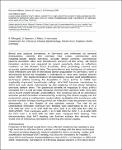Human immunodeficiency virus, hepatitis C and hepatitis B infections among blood donors in Germany 2000-2002: risk of virus transmission and the impact of nucleic acid amplification testing.
Offergeld, Ruth
Faensen, Daniel
Ritter, Sabine
Hamouda, Osamah
Blood and plasma donations in Germany are collected by several institutions, namely the German Red Cross, community and hospital-based blood services, private blood centres, commercial plasma donation sites and transfusion services of the army. All blood donation centres are required to report quarterly data on infection markers to the Robert Koch Institute, thus providing current and accurate epidemiological data. The prevalence and incidence of relevant viral infections are low in the blood donor population in Germany, with a decreasing trend for hepatitis C infections in new and repeat donors since 1997. The implementation of mandatory nucleic acid amplification technique (NAT) testing for hepatitis C virus (HCV) in 1999 has markedly improved transfusion safety. HIV-NAT became mandatory in 2004 but was done voluntarily by the majority of the blood donation services before then. The potential benefit of hepatitis B virus (HBV) minipool NAT is not as clear because chronic HBV carriers with very low virus levels might donate unidentified. The residual risk of an infectious window period donation inadvertently entering the blood supply can be estimated using a mathematic model which multiplies the incidence rate by the number of days during which an infection may be present but not detectable, i.e. the length of the window period. The risk of an undetected infection without NAT testing was estimated to be 1 in 2,770,000 for HIV, 1 in 670,000 for HCV and 1 in 230,000 for HBV in 2001/2002. This contrasts with 1 in 5,540,000 for HIV, 1 in 4,400,000 for HCV and 1 in 620,000 for HBV with minipool NAT testing. This demonstrates that NAT testing can further reduce the already very small risk of infectious donations entering the blood supply.
Dateien zu dieser Publikation
Keine Lizenzangabe
Verwandte Publikationen
Anzeige der Publikationen mit ähnlichem Titel, Autor, Urheber und Thema.
-
2005-12-22ZeitschriftenartikelA syringe exchange programme in prison as prevention strategy against HIV infection and hepatitis B and C in Berlin, Germany Stark, Klaus; Herrmann, U.; Ehrhardt, S.; Bienzle, UlrichIn two prisons in Berlin, Germany, provision of sterile injection equipment for injecting drug users (IDUs) started in 1998. To assess the programme's impact, the frequency of injecting drug use and syringe sharing, and ...
-
2015-07-06ZeitschriftenartikelOccult Hepatitis B Virus Infection in Nigerian Blood Donors and Hepatitis B Virus Transmission Risks Oluyinka, Opaleye O.; Tong, Hoang Van; Tien, Sy Bui; Fagbami, Ademola H.; Adekanle, Olusegun; Ojurongbe, Olusola; Bock, Thomas; Kremsner, Peter G.; Velavan, Thirumalaisamy P.Background: Occult hepatitis B virus infection (OBI) characterized by the absence of detectable HBsAg remains a potential threat in blood safety. We investigated the actual prevalence, viral factors and genotype of OBI ...
-
2015-10-14ZeitschriftenartikelExtended Microbiological Characterization of Göttingen Minipigs in the Context of Xenotransplantation: Detection and Vertical Transmission of Hepatitis E Virus Morozov, Vladimir A.; Morozov, Alexey V.; Rotem, Avi; Barkai, Uriel; Bornstein, Stefan; Denner, JoachimXenotransplantation has been proposed as a solution to the shortage of suitable human donors. Pigs are currently favoured as donor animals for xenotransplantation of cells, including islet cells, or organs. To reduce the ...

